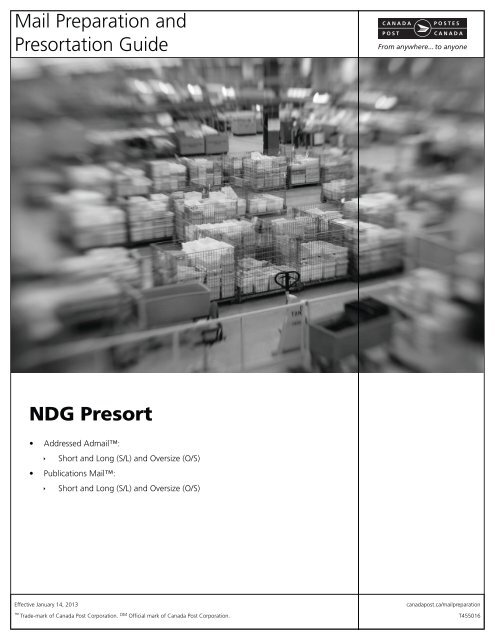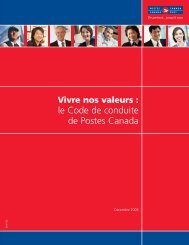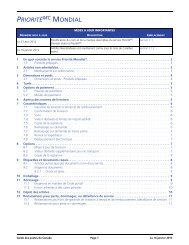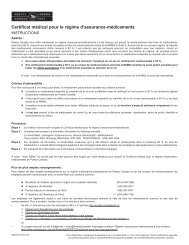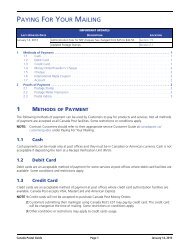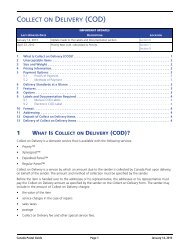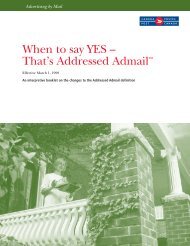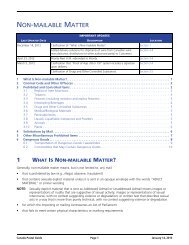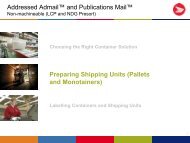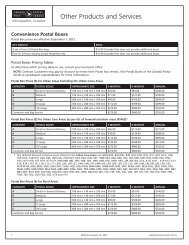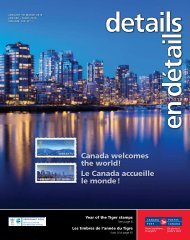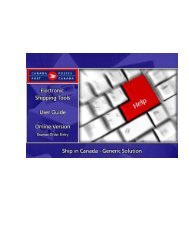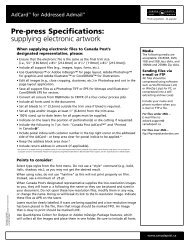Mail Preparation and Presortation Guide NDG Presort
Mail Preparation and Presortation Guide NDG Presort
Mail Preparation and Presortation Guide NDG Presort
Create successful ePaper yourself
Turn your PDF publications into a flip-book with our unique Google optimized e-Paper software.
<strong>Mail</strong> <strong>Preparation</strong> <strong>and</strong><br />
<strong><strong>Presort</strong>ation</strong> <strong>Guide</strong><br />
<strong>NDG</strong> <strong>Presort</strong><br />
• Addressed Admail:<br />
Short <strong>and</strong> Long (S/L) <strong>and</strong> Oversize (O/S)<br />
• Publications <strong>Mail</strong>:<br />
Short <strong>and</strong> Long (S/L) <strong>and</strong> Oversize (O/S)<br />
Effective January 14, 2013<br />
Trade-mark of Canada Post Corporation. OM Official mark of Canada Post Corporation.<br />
canadapost.ca/mailpreparation<br />
T455016
<strong>Mail</strong> <strong>Preparation</strong> <strong>and</strong> <strong><strong>Presort</strong>ation</strong> <strong>Guide</strong> – <strong>NDG</strong> <strong>Presort</strong><br />
IMPORTANT UPDATES<br />
Any description of change is provided for reference <strong>and</strong> convenience purposes only. The<br />
description of change does not form part of the Agreement between the Customer <strong>and</strong> Canada<br />
Post.<br />
Customers should ensure they are using the most current version of the <strong>Mail</strong> <strong>Preparation</strong> <strong>and</strong> <strong><strong>Presort</strong>ation</strong> <strong>Guide</strong>,<br />
including all amendments <strong>and</strong> other applicable documents, which are posted on the Canada Post website. See in<br />
particular, canadapost.ca/postalservices for key support documents.<br />
Important Updates:<br />
AMENDMENT/REVISION POSTED DATE EFFECTIVE DATE<br />
Revision v1.2 Posted on April 10, 2013 Effective on June 14, 2013<br />
The 2D barcode label is now available through your SERP recognized presortation Throughout document.<br />
software.<br />
Introduced Letterflatainer (LFT) as an acceptable container. Section 2.2.1.1<br />
Table 9<br />
Section 5.1<br />
Revision v1.1 Posted on December 14, 2012 Effective on January 14, 2013<br />
Notice: The 2D bar code requirement has been POSTPONED until further notice. Throughout document.<br />
Please continue to use the existing labels.<br />
Amendment v1.0 Posted on November 16, 2012 Effective on January 14, 2013<br />
Updated preserving integrity of mail preparation with a recommendation to add Section 3.3.3<br />
packing material when using bundle strapping as a separation method for any<br />
containers less than full.<br />
Introduced new optional 2D barcoded container label <strong>and</strong> shipping unit for Customers Section 3.3.4<br />
using SERP software to prepare their <strong>NDG</strong> <strong>Presort</strong> mailings.<br />
Updates on depositing mail, deposit locations <strong>and</strong> deposit types. Section 4.1<br />
Section 4.2<br />
Updated Do-It-Yourself checklist to reflect:<br />
Section 5.1<br />
• using packing to fill less than full containers to preserve integrity of mail preparation<br />
NOTE : This amendment updates the January 16, 2012 version 1.0 guide.<br />
When there is an amendment or a revision to the document, the version number will be modified as follows:<br />
• an amendment increases the first digit in the version (e.g., version 2.0, 3.0)<br />
• a revision increases the second digit in the version (e.g., version 1.1, 1.2)<br />
• the version number restarts at 1.0 every January of a given year.<br />
January 14, 2013 Version 1.2
TABLE OF CONTENTS<br />
<strong>NDG</strong> <strong>Presort</strong> . . . . . . . . . . . . . . . . . . . . . . . . . . . . . . . . . . . . . . . . . . . . . . . . . . . . . 1<br />
1 Overview. . . . . . . . . . . . . . . . . . . . . . . . . . . . . . . . . . . . . . . . . . . . . . . . . . . . . . . . . . . . . . . . . . . . . . . . . . . . . 1<br />
1.1 Who Should Use This <strong>Guide</strong>? . . . . . . . . . . . . . . . . . . . . . . . . . . . . . . . . . . . . . . . . . . . . . . . . . . . . . . . . 1<br />
1.2 What is <strong>NDG</strong> <strong>Presort</strong>? . . . . . . . . . . . . . . . . . . . . . . . . . . . . . . . . . . . . . . . . . . . . . . . . . . . . . . . . . . . . . . 1<br />
1.3 Key Requirements . . . . . . . . . . . . . . . . . . . . . . . . . . . . . . . . . . . . . . . . . . . . . . . . . . . . . . . . . . . . . . . . 1<br />
2 Before You Start . . . . . . . . . . . . . . . . . . . . . . . . . . . . . . . . . . . . . . . . . . . . . . . . . . . . . . . . . . . . . . . . . . . . . . . 2<br />
2.1 <strong>Presort</strong> Elements . . . . . . . . . . . . . . . . . . . . . . . . . . . . . . . . . . . . . . . . . . . . . . . . . . . . . . . . . . . . . . . . . 2<br />
2.1.1 Postal Code . . . . . . . . . . . . . . . . . . . . . . . . . . . . . . . . . . . . . . . . . . . . . . . . . . . . . . . . . . . . . . 2<br />
2.1.2 National <strong><strong>Presort</strong>ation</strong> Schematic (NPS) . . . . . . . . . . . . . . . . . . . . . . . . . . . . . . . . . . . . . . . . . . . 3<br />
2.2 Containerization . . . . . . . . . . . . . . . . . . . . . . . . . . . . . . . . . . . . . . . . . . . . . . . . . . . . . . . . . . . . . . . . . 4<br />
2.2.1 Acceptable Containers. . . . . . . . . . . . . . . . . . . . . . . . . . . . . . . . . . . . . . . . . . . . . . . . . . . . . . . 5<br />
2.2.1.1 Acceptable Canada Post-Supplied Containers . . . . . . . . . . . . . . . . . . . . . . . . . . . . 5<br />
2.2.1.2 Acceptable Cardboard Lettertainers. . . . . . . . . . . . . . . . . . . . . . . . . . . . . . . . . . . . 6<br />
2.2.1.3 Acceptable Customer-Supplied Cardboard Boxes. . . . . . . . . . . . . . . . . . . . . . . . . . 6<br />
2.2.2 Acceptable Shipping Units (Monotainers <strong>and</strong> Pallets) . . . . . . . . . . . . . . . . . . . . . . . . . . . . . . . . 6<br />
2.3 Creating Orders (Statements of <strong>Mail</strong>ing) . . . . . . . . . . . . . . . . . . . . . . . . . . . . . . . . . . . . . . . . . . . . . . . . 8<br />
3 <strong>Mail</strong> <strong>Preparation</strong> <strong>and</strong> <strong><strong>Presort</strong>ation</strong> . . . . . . . . . . . . . . . . . . . . . . . . . . . . . . . . . . . . . . . . . . . . . . . . . . . . . . . . 8<br />
3.1 Sequencing <strong>Mail</strong> Items . . . . . . . . . . . . . . . . . . . . . . . . . . . . . . . . . . . . . . . . . . . . . . . . . . . . . . . . . . . . . 9<br />
3.2 Grouping <strong>Mail</strong> Items . . . . . . . . . . . . . . . . . . . . . . . . . . . . . . . . . . . . . . . . . . . . . . . . . . . . . . . . . . . . . . 10<br />
3.2.1 Levels of Groupings . . . . . . . . . . . . . . . . . . . . . . . . . . . . . . . . . . . . . . . . . . . . . . . . . . . . . . . . 10<br />
3.2.2 Separating Groupings . . . . . . . . . . . . . . . . . . . . . . . . . . . . . . . . . . . . . . . . . . . . . . . . . . . . . . 12<br />
3.2.3 Identifying DCF, FCP <strong>and</strong> Residue Groupings . . . . . . . . . . . . . . . . . . . . . . . . . . . . . . . . . . . . . 15<br />
3.3 Placing Groupings in Containers . . . . . . . . . . . . . . . . . . . . . . . . . . . . . . . . . . . . . . . . . . . . . . . . . . . . . 16<br />
3.3.1 Levels of Containers. . . . . . . . . . . . . . . . . . . . . . . . . . . . . . . . . . . . . . . . . . . . . . . . . . . . . . . . 17<br />
3.3.2 Filling Containers . . . . . . . . . . . . . . . . . . . . . . . . . . . . . . . . . . . . . . . . . . . . . . . . . . . . . . . . . 18<br />
3.3.3 Preserving Integrity of <strong>Mail</strong> <strong>Preparation</strong> . . . . . . . . . . . . . . . . . . . . . . . . . . . . . . . . . . . . . . . . . 18<br />
3.3.4 Labelling Containers . . . . . . . . . . . . . . . . . . . . . . . . . . . . . . . . . . . . . . . . . . . . . . . . . . . . . . . 19<br />
3.4 Placing Containers into Shipping Units . . . . . . . . . . . . . . . . . . . . . . . . . . . . . . . . . . . . . . . . . . . . . . . . 23<br />
3.4.1 Levels of Shipping Units . . . . . . . . . . . . . . . . . . . . . . . . . . . . . . . . . . . . . . . . . . . . . . . . . . . . . 23<br />
3.4.2 Filling Shipping Units . . . . . . . . . . . . . . . . . . . . . . . . . . . . . . . . . . . . . . . . . . . . . . . . . . . . . . . 23<br />
3.4.3 Securing Pallets . . . . . . . . . . . . . . . . . . . . . . . . . . . . . . . . . . . . . . . . . . . . . . . . . . . . . . . . . . . 24<br />
3.4.4 Labelling Shipping Units. . . . . . . . . . . . . . . . . . . . . . . . . . . . . . . . . . . . . . . . . . . . . . . . . . . . . 24<br />
4 Deposit Sites . . . . . . . . . . . . . . . . . . . . . . . . . . . . . . . . . . . . . . . . . . . . . . . . . . . . . . . . . . . . . . . . . . . . . . . . 25<br />
4.1 Deposit Location Types . . . . . . . . . . . . . . . . . . . . . . . . . . . . . . . . . . . . . . . . . . . . . . . . . . . . . . . . . . . . 26<br />
4.2 Maximum Volumes Acceptable Per Day, by Deposit Location Type . . . . . . . . . . . . . . . . . . . . . . . . . . . 26<br />
5 Additional Resources . . . . . . . . . . . . . . . . . . . . . . . . . . . . . . . . . . . . . . . . . . . . . . . . . . . . . . . . . . . . . . . . . . 27<br />
5.1 Do-it-Yourself Checklist For Preparing <strong>NDG</strong> <strong>Presort</strong> <strong>Mail</strong>ings . . . . . . . . . . . . . . . . . . . . . . . . . . . . . . . . 27<br />
5.2 Using a Spreadsheet Application to Sequence Your <strong>Mail</strong>ing List . . . . . . . . . . . . . . . . . . . . . . . . . . . . . 28<br />
<strong>Mail</strong> <strong>Preparation</strong> <strong>and</strong> <strong><strong>Presort</strong>ation</strong> <strong>Guide</strong> Version 1.2 Page i January 14, 2013
<strong>NDG</strong> PRESORT<br />
1 OVERVIEW<br />
1.1 Who Should Use This <strong>Guide</strong>?<br />
This guide explains how to prepare <strong>NDG</strong> <strong>Presort</strong> mailings for the following services:<br />
• Addressed Admail: Short <strong>and</strong> Long (S/L) <strong>and</strong> Oversize (O/S)<br />
• Publications <strong>Mail</strong>: Short <strong>and</strong> Long (S/L) <strong>and</strong> Oversize (O/S).<br />
Please ensure you are using the most recent version of this guide <strong>and</strong> other support documents that detail our<br />
requirements, qualifications, terms <strong>and</strong> conditions, <strong>and</strong> pricing. These documents are available online at<br />
canadapost.ca/postalservices.<br />
It is your obligation to meet all the requirements outlined in your Customer Agreement.<br />
NOTE 1: Some words <strong>and</strong> expressions used in this document have a specific meaning. Please refer to Section 1<br />
"Definitions" of the General Terms <strong>and</strong> Conditions for the definition of specific terms referenced<br />
throughout this document <strong>and</strong> the Agreement.<br />
2: The figures in this document are used for illustration only.<br />
1.2 What is <strong>NDG</strong> <strong>Presort</strong>?<br />
<strong>NDG</strong> <strong>Presort</strong> is a mail preparation <strong>and</strong> presortation option that allows mailers to manually sort their mail items<br />
according to the National <strong><strong>Presort</strong>ation</strong> Schematic (NPS).<br />
“<strong>NDG</strong>” st<strong>and</strong>s for the “National Distribution <strong>Guide</strong>”, which is the former name of the National <strong><strong>Presort</strong>ation</strong><br />
Schematic (NPS) [see Section 2.1.2 "National <strong><strong>Presort</strong>ation</strong> Schematic (NPS)"]. When <strong>NDG</strong> was changed to NPS,<br />
the term <strong>NDG</strong> <strong>Presort</strong> was kept for operational reasons.<br />
1.3 Key Requirements<br />
To qualify for the <strong>NDG</strong> <strong>Presort</strong> option, your mailings must:<br />
• consist of items that meet the requirements specified in the applicable Canada Post Non-machineable Postal<br />
St<strong>and</strong>ards guide<br />
• be presorted as per the National <strong><strong>Presort</strong>ation</strong> Schematic (NPS)<br />
• be accompanied by Orders (Statements of <strong>Mail</strong>ing) prepared <strong>and</strong> submitted manually or by using Canada<br />
Post’s Electronic Shipping Tools (EST)<br />
• consist of:<br />
for Addressed Admail mailings: at least 1,000 items* per Order (Statement of <strong>Mail</strong>ing)<br />
for Publications <strong>Mail</strong> mailings:<br />
• at least 50 items per Order (Statement of <strong>Mail</strong>ing) for mailings comprised of <strong>NDG</strong> National items<br />
(phantom pricing is available at the <strong>NDG</strong> National base price)<br />
• no minimum volume requirement for mailings containing qualified <strong>NDG</strong> Regional** <strong>and</strong>/or Local<br />
Rural items (even if some <strong>NDG</strong> National items are included on the Order (Statement of <strong>Mail</strong>ing)<br />
<strong>Mail</strong> <strong>Preparation</strong> <strong>and</strong> <strong><strong>Presort</strong>ation</strong> <strong>Guide</strong> Version 1.2 Page 1 January 14, 2013
<strong>Mail</strong> <strong>Preparation</strong> <strong>and</strong> <strong><strong>Presort</strong>ation</strong> <strong>Guide</strong> – <strong>NDG</strong> <strong>Presort</strong><br />
• be deposited in Canada for delivery in Canada<br />
• meet all requirements <strong>and</strong> qualifications specified in your Customer Agreement <strong>and</strong> the applicable Customer<br />
<strong>Guide</strong>.<br />
* You may deposit less than the minimum volume provided you pay the applicable phantom price. The phantom price is only<br />
available for single deposits – it is not available on partial mailings.<br />
** In order to qualify for this price category, at least 50% of the total addressed copies in the mailing must be either Regional<br />
or a combination of Local Rural <strong>and</strong> Regional. Otherwise, <strong>NDG</strong> National prices will apply to the nominal Regional portion of<br />
the mailing.<br />
2 BEFORE YOU START<br />
<strong>NDG</strong> <strong>Presort</strong> mail must be presorted using the National <strong><strong>Presort</strong>ation</strong> Schematic (NPS). Here’s what that means:<br />
2.1 <strong>Presort</strong> Elements<br />
<strong>Mail</strong> <strong><strong>Presort</strong>ation</strong> is the process of sorting <strong>and</strong> grouping mail items bound for a common destination. <strong>Mail</strong><br />
presortation is based on the National <strong><strong>Presort</strong>ation</strong> Schematic (NPS) [see Section 2.1.2 "National <strong><strong>Presort</strong>ation</strong><br />
Schematic (NPS)"] <strong>and</strong> can be performed manually or by using presortation software recognized by Canada Post.<br />
<strong>Mail</strong> presortation involves the following:<br />
• sorting mail items by their Postal Code OM <strong>and</strong> according to the NPS<br />
• grouping mail items by a common destination according to the NPS.<br />
<strong>Mail</strong> <strong>Preparation</strong> is the process of preparing containers <strong>and</strong> shipping units for a common destination. It involves<br />
labelling groupings, containers <strong>and</strong> shipping units in such a way that Canada Post can bypass various processing<br />
steps <strong>and</strong> facilities within its mail distribution network.<br />
2.1.1 POSTAL CODE<br />
<strong>Mail</strong> presortation requires sorting mail items by Postal Code. The Postal Code is a six-character alphanumeric code<br />
in the form of ANA NAN, in which “A” represents a letter of the alphabet, <strong>and</strong> “N” represents a number. It is an<br />
integral part of every postal address in Canada, <strong>and</strong> was designed to help sort mail, both mechanically <strong>and</strong><br />
manually.<br />
The Postal Code is made up of two (2) segments, as shown in Figure 1:<br />
1. The first three characters (ANA) represent the Forward Sortation Area (FSA), a geographical region, <strong>and</strong><br />
2. The last three characters (NAN) represent the Local Delivery Unit (LDU), a specific city block or rural<br />
community.<br />
NOTE: Rural areas are identified by a zero in the FSA (e.g., M0L 3K2).<br />
Figure 1: Postal Code Segments<br />
FSA<br />
LDU<br />
January 14, 2013 Version 1.2 Page 2
<strong>Mail</strong> <strong>Preparation</strong> <strong>and</strong> <strong><strong>Presort</strong>ation</strong> <strong>Guide</strong> – <strong>NDG</strong> <strong>Presort</strong><br />
The first character of the Postal Code identifies one of the 18 major geographic areas, provinces or districts (see<br />
Figure 2).<br />
Figure 2: Major Geographic Areas Identified by the First Character of the Postal Code<br />
Y<br />
Yukon<br />
X<br />
Northwest<br />
Territories<br />
X<br />
Nunavut<br />
Newfoundl<strong>and</strong> <strong>and</strong> Labrador<br />
A<br />
V<br />
T S R<br />
G<br />
(Eastern<br />
Québec)<br />
A<br />
British<br />
Columbia<br />
Alberta<br />
Saskatchewan<br />
Manitoba<br />
P<br />
(Northern<br />
Ontario)<br />
N<br />
(Southwestern<br />
Ontario)<br />
L<br />
(Central<br />
Ontario)<br />
Ontario<br />
J<br />
(Western<br />
Québec)<br />
Québec<br />
M<br />
(Metropolitan<br />
Toronto)<br />
E<br />
C<br />
New<br />
Brunswick<br />
H<br />
(Metropolitan<br />
Montréal)<br />
K<br />
(Eastern<br />
Ontario)<br />
Prince Edward<br />
Isl<strong>and</strong><br />
B<br />
Nova Scotia<br />
For more detailed information, please visit Section 5 of Addressing <strong>Guide</strong>lines in the Canada Postal <strong>Guide</strong>.<br />
2.1.2 NATIONAL PRESORTATION SCHEMATIC (NPS)<br />
The National <strong><strong>Presort</strong>ation</strong> Schematic (NPS) indicates how mail in Canada is distributed through specific Canada<br />
Post facilities. It lists all Forward Sortation Areas (FSAs) <strong>and</strong> shows how to consolidate mail into groupings <strong>and</strong><br />
containers.<br />
The four NPS levels of consolidation are (as shown in Figure 3):<br />
NPS Level 1 – Delivery Facility (DF)<br />
NPS Level 2 – City<br />
NPS Level 3 – Distribution Centre Facility (DCF)<br />
NPS Level 4 – Forward Consolidation Point (FCP)<br />
Any mail items that cannot be consolidated to one (1) of these four levels will be consolidated as Residue.<br />
January 14, 2013 Version 1.2 Page 3
<strong>Mail</strong> <strong>Preparation</strong> <strong>and</strong> <strong><strong>Presort</strong>ation</strong> <strong>Guide</strong> – <strong>NDG</strong> <strong>Presort</strong><br />
Figure 3: Illustration of the NPS<br />
FSA LEVEL 1<br />
DELIVERY FACILITY<br />
(DF)<br />
LEVEL 2<br />
CITY<br />
LEVEL 3<br />
DISTRIBUTION CENTRE<br />
FACILITY<br />
(DCF)<br />
LEVEL 4<br />
FORWARD<br />
CONSOLIDATION POINT<br />
(FCP)<br />
K2S<br />
K0A<br />
K2S 1A0<br />
STITTSVILLE ON<br />
K0A 9ZO<br />
OTTAWA ON<br />
DCF<br />
K7K<br />
K7L<br />
K7M<br />
K7N<br />
K7P<br />
K7L 1X0<br />
KINGSTON ON<br />
STN MAIN<br />
K7M 5E0<br />
KINGSTON ON<br />
STN A<br />
K7L 1X0<br />
KINGSTON ON<br />
K0H 9ZO<br />
KINGSTON ON<br />
DCF<br />
K0A 9ZO<br />
OTTAWA ON<br />
FWD<br />
K0H<br />
K1P<br />
K1R<br />
K2P<br />
K1L<br />
K1M<br />
K1N<br />
K1G 2C0<br />
OTTAWA ON<br />
LCD CENTRETOWN<br />
K1L 5A0<br />
OTTAWA ON<br />
STN VANIER<br />
K1G 0A0<br />
OTTAWA ON<br />
NOTE:<br />
Canada Post updates the NPS monthly to reflect the changing inventory of Canadian addresses. In order<br />
to receive optimal service <strong>and</strong> avoid surcharges, you must ensure that you are using the most current<br />
version of the NPS which can be found at canadapost.ca/nps.<br />
2.2 Containerization<br />
Containerization is the process of packaging the mail for shipment. <strong>Mail</strong> items are placed into containers suitable<br />
for h<strong>and</strong>ling through Canada Post’s processes. These containers are then placed into shipping units (pallets or<br />
monotainers) suitable for h<strong>and</strong>ling through our transportation network.<br />
You may enquire about or order our equipment by contacting the National Equipment Container Facility (NECF)<br />
Order Desk, by telephone at 905.565.0480, by fax at 905.564.6830, by email at necfteo@canadapost.ca or<br />
through a Regional Equipment Coordinator.<br />
Please note that Canada Post’s equipment may only be used when using Canada Post’s products or services. It<br />
remains our exclusive property. Personal use is not permitted. You are responsible for ensuring that the<br />
equipment remains in good condition, reasonable wear-<strong>and</strong>-tear accepted.<br />
NOTE 1: The minimum ordering quantity for plastic pallets is 40 units.<br />
2: Effective January 16, 2012, Canada Post no longer accepts Addressed Admail <strong>and</strong> Publications <strong>Mail</strong><br />
mailings inducted in bags.<br />
January 14, 2013 Version 1.2 Page 4
<strong>Mail</strong> <strong>Preparation</strong> <strong>and</strong> <strong><strong>Presort</strong>ation</strong> <strong>Guide</strong> – <strong>NDG</strong> <strong>Presort</strong><br />
2.2.1 ACCEPTABLE CONTAINERS<br />
The acceptable containers for <strong>NDG</strong> <strong>Presort</strong> are Canada Post-supplied containers (lettertainers <strong>and</strong> flats tubs).<br />
Alternative acceptable container options for <strong>NDG</strong> <strong>Presort</strong> are:<br />
• Cardboard Lettertainers (see Section 2.2.1.2)<br />
• Customer-supplied cardboard boxes (see Section 2.2.1.3).<br />
NOTE 1: Cardboard Lettertainers are only permitted for Short <strong>and</strong> Long (S/L) items.<br />
2: Customers are allowed to use Cardboard Lettertainers or Customer-supplied cardboard boxes in<br />
conjunction with Canada Post-supplied lettertainers or flats tubs, provided the same type of container is<br />
used for each destination facility.<br />
2.2.1.1 Acceptable Canada Post-Supplied Containers<br />
The acceptable containers for <strong>NDG</strong> <strong>Presort</strong> are lettertainers, letterflatainers (LFTs) <strong>and</strong> flats tubs.<br />
Lettertainers (see Figure 4) <strong>and</strong> Letterflatainers (LFTs) (see Figure 5) are used for Short <strong>and</strong> Long (S/L)<br />
Addressed Admail <strong>and</strong> Publications <strong>Mail</strong> items.<br />
Figure 4: Lettertainer<br />
Figure 5: Letterflatainer (LFT)<br />
Flats tubs (see Figure 6) are used for Oversize (O/S) Addressed Admail <strong>and</strong> Publications <strong>Mail</strong> items.<br />
Figure 6: Flats Tub<br />
All containers must be deposited with lids, unless other arrangements have been made with a Canada Post<br />
representative. Letterflatainers (LFTs) do not require lids. Please refer to Table 1 for container specifications.<br />
NOTE:<br />
Containers prepared in a Level 1 (DF) monotainer (see Section 3.4.1 "Levels of Shipping Units") may be<br />
nested <strong>and</strong> deposited without lids. In such cases, we recommend covering monotainers with cardboard<br />
to protect the load.<br />
January 14, 2013 Version 1.2 Page 5
<strong>Mail</strong> <strong>Preparation</strong> <strong>and</strong> <strong><strong>Presort</strong>ation</strong> <strong>Guide</strong> – <strong>NDG</strong> <strong>Presort</strong><br />
Table 1: Container Specifications<br />
TYPE OF<br />
CONTAINER<br />
Lettertainer<br />
Letterflatainer (LFT)<br />
Flats Tub<br />
WEIGHT LENGTH WIDTH HEIGHT MAXIMUM WEIGHT<br />
(INCLUDING MAIL,<br />
CONTAINER & LID)<br />
1.8 kg<br />
(4 lbs)<br />
1.4 kg<br />
(3.2 lbs)<br />
1.7 kg<br />
(3.7 lbs)<br />
535 mm<br />
(21.1 in)<br />
480 mm<br />
(18.9 in)<br />
405 mm<br />
(15.9 in)<br />
251 mm<br />
(9.8 in)<br />
300 mm<br />
(11.8 in)<br />
240 mm<br />
(9.4 in)<br />
156 mm<br />
(6.1 in)<br />
170 mm<br />
(6.7 in)<br />
303 mm<br />
(11.9 in)<br />
22.7 kg<br />
(50 lbs)<br />
22.7 kg<br />
(50 lbs)<br />
22.7 kg<br />
(50 lbs)<br />
NOTE:<br />
Container dimensions in Table 1 are the measurements inside the container.<br />
2.2.1.2 Acceptable Cardboard Lettertainers<br />
Cardboard Lettertainers are an alternative single-use container option for Short <strong>and</strong> Long (S/L) Addressed Admail<br />
<strong>and</strong> Publications <strong>Mail</strong> items.<br />
Customers can purchase Cardboard Lettertainers from Canada Post online at canadapost.ca/obc (product code:<br />
241560) or directly from participating manufacturers.<br />
Cardboard Lettertainers must meet all requirements outlined in this guide.<br />
Visit canadapost.ca/mailpreparation for more information on Cardboard Lettertainers.<br />
2.2.1.3 Acceptable Customer-Supplied Cardboard Boxes<br />
Customer-supplied cardboard boxes are acceptable for Short <strong>and</strong> Long (S/L) <strong>and</strong> Oversize (O/S) Addressed Admail<br />
<strong>and</strong> Publications <strong>Mail</strong> items.<br />
Customer-supplied cardboard boxes must:<br />
• meet the requirements outlined in this guide<br />
• have lids <strong>and</strong> be sturdy to withst<strong>and</strong> h<strong>and</strong>ling during processing<br />
• not exceed the dimensions outlined in Table 2.<br />
Table 2: Cardboard Box Specifications<br />
TYPE OF<br />
MAIL ITEMS<br />
Short <strong>and</strong> Long (S/L)<br />
Oversize (O/S)<br />
LENGTH WIDTH HEIGHT MAXIMUM WEIGHT<br />
(INCLUDING MAIL)<br />
535 mm<br />
(21.1 in)<br />
405 mm<br />
(15.9 in)<br />
251 mm<br />
(9.8 in)<br />
240 mm<br />
(9.4 in)<br />
156 mm<br />
(6.1 in)<br />
303 mm<br />
(11.9 in)<br />
22.7 kg<br />
(50 lbs)<br />
22.7 kg<br />
(50 lbs)<br />
NOTE:<br />
Dimensions in Table 2 are the measurements inside the cardboard box.<br />
2.2.2 ACCEPTABLE SHIPPING UNITS (MONOTAINERS AND PALLETS)<br />
Monotainers <strong>and</strong> pallets (also referred to as skids) are acceptable shipping units for containers (see Table 3 <strong>and</strong><br />
Table 4).<br />
Use of monotainers or pallets is optional.<br />
Shipping units are used to group containers intended for one Order (Statement of <strong>Mail</strong>ing) or bound for the same<br />
destination (e.g., all mail items for Vancouver arrive on one pallet). This reduces the h<strong>and</strong>ling <strong>and</strong> helps ensure<br />
timely delivery.<br />
January 14, 2013 Version 1.2 Page 6
<strong>Mail</strong> <strong>Preparation</strong> <strong>and</strong> <strong><strong>Presort</strong>ation</strong> <strong>Guide</strong> – <strong>NDG</strong> <strong>Presort</strong><br />
Table 3: Acceptable Shipping Units<br />
CANADA POST-SUPPLIED<br />
CUSTOMER-SUPPLIED<br />
MONOTAINER PLASTIC PALLET WOODEN PALLET<br />
Table 4: Shipping Unit Specifications<br />
TYPE OF<br />
SHIPPING UNIT<br />
Monotainer<br />
Pallet<br />
WEIGHT LENGTH WIDTH MAXIMUM HEIGHT<br />
(INCLUDING MAIL &<br />
SHIPPING UNIT)<br />
97 kg<br />
(213.8 lbs)<br />
9 kg*<br />
(19.8 lbs)<br />
1.322 m<br />
(52 in)<br />
1.22 m<br />
(48 in)<br />
1.067 m<br />
(42 in)<br />
1.02 m<br />
(40 in)<br />
1.115 m<br />
(43.8 in)<br />
1.5 m<br />
(59 in)<br />
MAXIMUM WEIGHT<br />
(INCLUDING MAIL &<br />
SHIPPING UNIT)<br />
900 kg<br />
(1,984.2 lbs)<br />
900 kg<br />
(1,984.2 lbs)<br />
* 9 kg (19.8 lbs) is the weight of a plastic pallet supplied by Canada Post.<br />
If you are supplying your own wooden pallets, we recommend the bloc design to be used (as shown in Table 3).<br />
In addition, the following requirements must be met:<br />
• pallets must not have critical defects (i.e. exposed nails, significant splits, missing wood, decay or damaged/<br />
jagged parts)<br />
• the top surface of the pallet must be flat <strong>and</strong> stable, allowing for safe loading <strong>and</strong> unloading of mail without<br />
tipping or sliding<br />
• pallets must be able to withst<strong>and</strong> temperatures of -40°C to 40°C, <strong>and</strong> severe weather conditions such as<br />
rain, snow, ice <strong>and</strong> humidity<br />
• pallets must be built so their bottom deck boards do not obstruct entry by a forklift. Pallets should be<br />
accessible by a forklift on all four sides <strong>and</strong> by a h<strong>and</strong> jack on two sides<br />
• openings for forks must be:<br />
at least 102 mm (4”) in height on the sides of the pallet without bottom deck boards; <strong>and</strong><br />
at least 89 mm (3.5”) in height on the sides with bottom deck boards<br />
• metal strapping is not permitted<br />
• pallets must conform to:<br />
<br />
<br />
<br />
ASTM - D1185 - St<strong>and</strong>ard Test Methods for Pallets <strong>and</strong> related Structures Employed in Materials H<strong>and</strong>ling<br />
<strong>and</strong> Shipping<br />
ISO-8611 - Pallets for Materials H<strong>and</strong>ling - Flat Pallets- Part 3: Maximum Working Loads<br />
Uniform St<strong>and</strong>ard for Wood Pallets by National Wooden Pallet & Container Association (USA).<br />
January 14, 2013 Version 1.2 Page 7
35 BRACO ST<br />
OTTAWA ON K2L 1B6<br />
35 BRACO ST<br />
OTTAWA ON K2L 1B6<br />
35 BRACO ST<br />
OTTAWA ON K2L 1B6<br />
35 BRACO ST<br />
OTTAWA ON K2L 1B6<br />
35 BRACO ST<br />
OTTAWA ON K2L 1B6<br />
<strong>Mail</strong> <strong>Preparation</strong> <strong>and</strong> <strong><strong>Presort</strong>ation</strong> <strong>Guide</strong> – <strong>NDG</strong> <strong>Presort</strong><br />
2.3 Creating Orders (Statements of <strong>Mail</strong>ing)<br />
We recommend that you prepare <strong>and</strong> submit your Orders (Statements of <strong>Mail</strong>ing) using Canada Post’s Electronic<br />
Shipping Tools (EST).<br />
EST can be accessed free of charge once you register for a user ID <strong>and</strong> password at canadapost.ca/newuser.<br />
Two EST user platforms are available: an online <strong>and</strong> a desktop version. Please visit canadapost.ca/est to learn<br />
more about EST <strong>and</strong> its different versions.<br />
For technical enquiries regarding EST, please call the EST Help Desk at 1.866.511.0546.<br />
NOTE:<br />
Manual Orders (Statements of <strong>Mail</strong>ing) are also acceptable; however they are subject to a manual Order<br />
processing fee.<br />
3 MAIL PREPARATION AND PRESORTATION<br />
The mail preparation <strong>and</strong> presortation process requires (as shown in Figure 7):<br />
• sequencing mail items by Postal Code as per the National <strong><strong>Presort</strong>ation</strong> Schematic (NPS) <strong>and</strong> placing them in<br />
a specific (address-based) order<br />
• grouping mail items for a common destination <strong>and</strong> placing them in a specific (address-based) order<br />
• placing groupings with a common destination into containers in a specific order, <strong>and</strong><br />
• placing containers with a common destination into shipping units (monotainers or pallets) - optional.<br />
Figure 7: <strong>Mail</strong> <strong>Preparation</strong> <strong>and</strong> <strong><strong>Presort</strong>ation</strong> Process<br />
<strong>Mail</strong> items<br />
Section 2<br />
• Meet non-machineable specifications<br />
ABC COMPANY<br />
RR1<br />
ABC COMPANY ALMONTE ON K0A 1A1<br />
RR1<br />
ABC COMPANY ALMONTE ON K0A 1A1<br />
RR1<br />
ABC COMPANY ALMONTE ON K0A 1A0<br />
RR1<br />
ABC COMPANY ALMONTE ON K0A 1A0<br />
RR1<br />
ALMONTE ON K0A 1A0<br />
Items must be<br />
sequenced<br />
as per NPS<br />
Section 3.1<br />
• Sequencing mail items by Postal Codes<br />
Items must be<br />
grouped together<br />
(GROUPINGS)<br />
Section 3.2<br />
• Minimum number of items per grouping<br />
• Levels of groupings<br />
• Separating groupings<br />
• Identifying DCF, FCP <strong>and</strong> Residue groupings<br />
Groupings must<br />
be placed into<br />
CONTAINERS<br />
Section 3.3<br />
• Maximum weight of a filled container<br />
• Levels of containers<br />
• Filling containers<br />
• Labelling containers<br />
Containers are<br />
placed into<br />
SHIPPING UNITS<br />
(optional)<br />
Section 3.4<br />
• Levels of shipping units<br />
• Filling shipping units<br />
• Securing pallets<br />
• Labelling shipping units<br />
January 14, 2013 Version 1.2 Page 8
<strong>Mail</strong> <strong>Preparation</strong> <strong>and</strong> <strong><strong>Presort</strong>ation</strong> <strong>Guide</strong> – <strong>NDG</strong> <strong>Presort</strong><br />
3.1 Sequencing <strong>Mail</strong> Items<br />
Start by sequencing your mailing by Postal Codes according to the National <strong><strong>Presort</strong>ation</strong> Schematic (NPS) (see<br />
Figure 8).<br />
NOTE 1: Customers may use presortation software recognized by Canada Post to presort their mailings. The<br />
presortation software will determine mail item sequencing. It will also determine which groupings<br />
<strong>and</strong> containers can be created for a given mailing. If you are using the presortation software to<br />
prepare your mailing, you must ensure that you are using the most current version of it in order to<br />
receive optimal service <strong>and</strong> avoid surcharges. For more information on presortation software,<br />
please visit canadapost.ca/presortationsoftware, or<br />
2: Customers may use a spreadsheet application, such as Microsoft Excel, in conjunction with the NPS<br />
to presort their mailings (see Section 5.2 "Using a Spreadsheet Application to Sequence Your<br />
<strong>Mail</strong>ing List").<br />
Figure 8: Sequencing <strong>Mail</strong> Items by Postal Codes According to the National <strong><strong>Presort</strong>ation</strong> Schematic<br />
(NPS)<br />
H7L 4A8<br />
H7L 3W3<br />
H4C 1V8<br />
H3H 3A7<br />
H3H 3A7<br />
H3H 2P3<br />
H3B 1S6<br />
H3A 3LA<br />
H3A 2N4<br />
H2R 2Z7<br />
B4R 6Y5<br />
B4R 6Y1<br />
B4R 6X4<br />
B4R 3X2<br />
B4R 2X6<br />
B4R 2V9<br />
B4P 2B8<br />
B4N 3C4<br />
B6L 2S4<br />
B6L 1B8<br />
B2N 2X8<br />
B2N 1S0<br />
B3E 1N4<br />
B2T 4R5<br />
B2T 3R9<br />
B2S 4S5<br />
A1B 3R9<br />
A1B 3R9<br />
NOTE:<br />
The example is for illustration only <strong>and</strong> may not reflect the current National <strong><strong>Presort</strong>ation</strong> Schematic (NPS)<br />
order.<br />
January 14, 2013 Version 1.2 Page 9
<strong>Mail</strong> <strong>Preparation</strong> <strong>and</strong> <strong><strong>Presort</strong>ation</strong> <strong>Guide</strong> – <strong>NDG</strong> <strong>Presort</strong><br />
3.2 Grouping <strong>Mail</strong> Items<br />
All items in a mailing must be part of a grouping. All groupings (except Residue) must have a minimum of eight<br />
(8) items for Addressed Admail mailings or a minimum of six (6) items for Publications <strong>Mail</strong> mailings. If this<br />
minimum requirement is not met, the items are consolidated to the next level (see Section 3.2.1 "Levels of<br />
Groupings").<br />
Grouped mail items must meet the consolidation requirements set out in Canada Post’s National <strong><strong>Presort</strong>ation</strong><br />
Schematic (NPS).<br />
3.2.1 LEVELS OF GROUPINGS<br />
There are four (4) allowable types of groupings:<br />
1. NPS Level 1 – Delivery Facility (DF)<br />
2. NPS Level 3 – Distribution Centre Facility (DCF)<br />
3. NPS Level 4 – Forward Consolidation Point (FCP)<br />
4. Residue.<br />
You have to group together mail items that have a common destination <strong>and</strong>/or sortation. For example:<br />
• group all items delivered from the same postal station or letter carrier depot (a DF grouping)<br />
• group all items delivered in the same area, such as a city <strong>and</strong> surrounding area (a DCF grouping)<br />
• group all items delivered in the same province (an FCP grouping)<br />
• place all remaining items into a Residue grouping.<br />
You begin by separating mail items by their province or district of destination (see Figure 9).<br />
Figure 9: Separating <strong>Mail</strong> Items by Areas of Destination<br />
A1B 3R9<br />
A1B 3R9<br />
B4R 6Y5<br />
B4R 6Y1<br />
B4R 6X4<br />
B4R 3X2<br />
B4R 2X6<br />
B4R 2V9<br />
B4P 2B8<br />
B4N 3C4<br />
B6L 2S4<br />
B6L 1B8<br />
B2N 2X8<br />
B2N 1S0<br />
B3E 1N4<br />
B2T 4R5<br />
B2T 3R9<br />
B2S 4S5<br />
H7L 4A8<br />
H7L 3W3<br />
H4C 1V8<br />
H3H 3A7<br />
H3H 3A7<br />
H3H 2P3<br />
H3B 1S6<br />
H3A 3LA<br />
H3A 2N4<br />
H2R 2Z7<br />
All mail items destined<br />
to Newfoundl<strong>and</strong><br />
All mail items destined<br />
to Nova Scotia<br />
All mail items destined<br />
to Quebec<br />
January 14, 2013 Version 1.2 Page 10
<strong>Mail</strong> <strong>Preparation</strong> <strong>and</strong> <strong><strong>Presort</strong>ation</strong> <strong>Guide</strong> – <strong>NDG</strong> <strong>Presort</strong><br />
Then:<br />
• if not enough items to create an FCP grouping, create Residue grouping (see Figure 10); however, if enough<br />
items to create an FCP grouping, check the NPS if DCF grouping(s) can be created<br />
• if not enough items to create a DCF grouping, create FCP grouping (see Figure 11); however, if enough items<br />
to create a DCF grouping, check the NPS if DF grouping(s) can be created<br />
• if not enough items to create a DF grouping, create DCF grouping or consolidate to FCP or Residue<br />
groupings; however, if enough items to create a DF grouping, create DF grouping(s) (see Figure 12).<br />
Figure 10: Creating Residue Groupings<br />
A1B 3R9<br />
A1B 3R9<br />
Enough<br />
items to<br />
create FCP<br />
grouping?<br />
No<br />
Create Residue<br />
grouping<br />
Figure 11: Creating FCP <strong>and</strong> DCF Groupings<br />
B4R 6Y5<br />
B4R 6Y1<br />
B4R 6X4<br />
B4R 3X2<br />
B4R 2X6<br />
B4R 2V9<br />
B4P 2B8<br />
B4N 3C4<br />
B6L 2S4<br />
B6L 1B8<br />
B2N 2X8<br />
B2N 1S0<br />
B3E 1N4<br />
B2T 4R5<br />
B2T 3R9<br />
B2S 4S5<br />
Enough<br />
items to<br />
create FCP<br />
grouping?<br />
Yes<br />
Check NPS if<br />
DCF grouping(s)<br />
can be created<br />
B2S 4S5<br />
B2T 3R9<br />
B2T 4R5<br />
B3E 1N4<br />
B2N 1S0<br />
B2N 2X8<br />
B6L 1B8<br />
B6L 2S4<br />
Halifax NS<br />
DCF<br />
Truro NS DCF<br />
Enough<br />
items to<br />
create DCF<br />
grouping?<br />
Enough<br />
items to<br />
create DCF<br />
grouping?<br />
No<br />
No<br />
Create FCP<br />
grouping<br />
destined to<br />
Halifax NS FWD<br />
B4N 3C4<br />
B4P 2B8<br />
B4R 2V9<br />
B4R 2X6<br />
B4R 3X2<br />
Kentville NS<br />
DCF<br />
Enough<br />
items to<br />
create DCF<br />
grouping?<br />
Yes<br />
Create DCF<br />
grouping<br />
destined to<br />
Kentville NS DCF<br />
B4R 6X4<br />
B4R 6Y1<br />
B4R 6Y5<br />
January 14, 2013 Version 1.2 Page 11
<strong>Mail</strong> <strong>Preparation</strong> <strong>and</strong> <strong><strong>Presort</strong>ation</strong> <strong>Guide</strong> – <strong>NDG</strong> <strong>Presort</strong><br />
Figure 12: Creating DF Groupings<br />
H7L 4A8<br />
H7L 3W3<br />
H4C 1V8<br />
H3H 3A7<br />
H3H 3A7<br />
H3H 2P3<br />
H3B 1S6<br />
H3A 3LA<br />
H3A 2N4<br />
H2R 2Z7<br />
Enough<br />
items to<br />
create FCP<br />
grouping?<br />
Yes<br />
Check NPS if<br />
DCF grouping(s)<br />
can be created<br />
H2R 2Z7<br />
H3A 2N4<br />
H3A 3L4<br />
H3B 1S6<br />
H3H 2P3<br />
H3H 3A7<br />
H3H 3A7<br />
H4C 1V8<br />
H7L 3W3<br />
H7L 4A8<br />
Montreal QC<br />
Enough<br />
items to<br />
create DCF<br />
grouping?<br />
Yes<br />
Check NPS if<br />
DF grouping(s)<br />
can be created<br />
H2R 2Z7<br />
H3A 2N4<br />
H3A 3L4<br />
H3B 1S6<br />
H3H 2P3<br />
H3H 3A7<br />
Montreal QC<br />
LCD Bridge 1<br />
Enough<br />
items to<br />
create DF<br />
grouping?<br />
Yes<br />
Create DF<br />
grouping<br />
H3H 3A7<br />
H4C 1V8<br />
H7L 3W3<br />
H7L 4A8<br />
Montreal QC<br />
LCD Monterey 1<br />
Enough<br />
items to<br />
create DF<br />
grouping?<br />
No<br />
Consolidate to<br />
DCF, FCP or<br />
Residue<br />
For each grouping you create, sequence the mail items within the grouping.<br />
3.2.2 SEPARATING GROUPINGS<br />
Once your mail has been presorted, make sure it can withst<strong>and</strong> h<strong>and</strong>ling. Preserve the integrity of your groupings<br />
by separating them in their containers, using one of the following acceptable methods:<br />
a) bundling<br />
b) separator cards<br />
c) edgemarking.<br />
<strong>Mail</strong> items within groupings must all face the same direction.<br />
A) Bundling<br />
A bundle is a group of mail items secured together by strapping (using elastic b<strong>and</strong>s, string, or plastic straps) or<br />
by shrink-wrapping. Please refer to Table 5 for bundle requirements.<br />
January 14, 2013 Version 1.2 Page 12
<strong>Mail</strong> <strong>Preparation</strong> <strong>and</strong> <strong><strong>Presort</strong>ation</strong> <strong>Guide</strong> – <strong>NDG</strong> <strong>Presort</strong><br />
Table 5: Bundle Requirements<br />
TYPE OF MAILING MAXIMUM BUNDLE THICKNESS MINIMUM NUMBER OF ITEMS*<br />
PER BUNDLE<br />
Short <strong>and</strong> Long (S/L) Addressed Admail<br />
<strong>and</strong> Publications <strong>Mail</strong><br />
Oversize (O/S) Addressed Admail <strong>and</strong><br />
Publications <strong>Mail</strong><br />
100 mm<br />
(4 in) six (6) for Publications <strong>Mail</strong><br />
200 mm<br />
eight (8) for Addressed Admail<br />
(8 in)<br />
* The maximum thickness takes precedence over the minimum number of items. The last Residue bundle has no minimum<br />
number of items, although it still must follow the specifications for maximum thickness per bundle.<br />
NOTE 1: When a bundle exceeds the maximum thickness <strong>and</strong> there are sufficient items to create a full second<br />
bundle, it is preferable to split the total number of items into two (2) equal bundles, rather than create<br />
one (1) full bundle <strong>and</strong> one (1) very small bundle. For example, if there is a Short <strong>and</strong> Long (S/L) bundle<br />
of 52 items with a thickness of 125 mm, make two (2) bundles of 26 items.<br />
2: When a bundle of Oversize (O/S) items exceeds the thickness of 200 mm, it is preferable to make two<br />
(2) evenly divided bundles.<br />
Strapping must be strong <strong>and</strong> tight enough to hold the bundle together, without the contents sliding, when<br />
held vertically. Please refer to Table 6 for strapping requirements.<br />
Table 6: Strapping Requirements for Containers<br />
TYPE OF MAILING<br />
• Short <strong>and</strong> Long (S/L) Addressed Admail <strong>and</strong> Publications <strong>Mail</strong><br />
• Oversize (O/S) Addressed Admail <strong>and</strong> Publications <strong>Mail</strong> for Level 1 of the NPS only<br />
STRAPPING REQUIREMENT<br />
• Oversize (O/S) Addressed Admail <strong>and</strong> Publications <strong>Mail</strong> (except for Level 1 of the NPS)<br />
Single strapping<br />
Double strapping<br />
Shrink-wrapping is an acceptable method of bundling for Oversize (O/S) Addressed Admail <strong>and</strong> Publications<br />
<strong>Mail</strong> items. The plastic used for shrink-wrapping must be strong enough to ensure the bundles remain secured<br />
during h<strong>and</strong>ling.<br />
NOTE: If your mail items are bound using spines, to create an even bundle, you may place the bottom half of<br />
the bundle with its spines facing the opposite way to the top half of the bundle (see Figure 13).<br />
Figure 13: Bundling Items with Spines<br />
Acceptable<br />
Preferred<br />
January 14, 2013 Version 1.2 Page 13
<strong>Mail</strong> <strong>Preparation</strong> <strong>and</strong> <strong><strong>Presort</strong>ation</strong> <strong>Guide</strong> – <strong>NDG</strong> <strong>Presort</strong><br />
B) Separator Cards<br />
Separator cards may also be used to indicate breaks between groupings (as shown in Figure 14). Separator cards<br />
must:<br />
• be made of thin, rigid cardboard (a weight of 120 to 160 grams per square metre is normally adequate)<br />
• extend at least 20 mm above the mail items<br />
• be at least 155 mm wide<br />
• be placed in front of the first mail item in each grouping. Please note that if a grouping is too large to fit into<br />
one container, a second separator card is required at the front of the second container.<br />
Figure 14: Separator Cards<br />
20 mm min.<br />
155 mm min.<br />
Destination Plant: Établi sement de destination:<br />
NOTE: Separator cards can be any colour.<br />
When separator cards are used, the minimum number of items per grouping is six (6) for Publications <strong>Mail</strong> <strong>and</strong><br />
eight (8) for Addressed Admail. There is no maximum number of items per grouping. Only one separator card is<br />
required to identify the start of each grouping, regardless of its size.<br />
C) Edgemarking<br />
Edgemarking means applying ink or paint to the top edge of a mail item. This is another acceptable way of<br />
separating groupings within a container (see Figure 15). Edgemarks are only applied to the first item in each<br />
grouping.<br />
Edgemarks must meet the following requirements:<br />
• their colour must significantly contrast with that of the mail item<br />
• the same colour must be used for edgemarking the entire mailing<br />
• they must begin approximately 40 mm from the upper-right edge of the mail item<br />
• edgemarks should be approximately 20 mm long, separated by a gap of approximately 25 mm:<br />
the marking nearest the upper-right edge indicates a Delivery Facility (DF) grouping<br />
the additional markings indicate Distribution Centre Facility (DCF) <strong>and</strong> Forward Consolidation Point (FCP)<br />
groupings.<br />
January 14, 2013 Version 1.2 Page 14
<strong>Mail</strong> <strong>Preparation</strong> <strong>and</strong> <strong><strong>Presort</strong>ation</strong> <strong>Guide</strong> – <strong>NDG</strong> <strong>Presort</strong><br />
Figure 15: Edgemarking<br />
Third<br />
marking<br />
indicates<br />
FCP<br />
grouping<br />
Second<br />
marking<br />
indicates<br />
DCF<br />
grouping<br />
First<br />
marking<br />
indicates<br />
DF<br />
grouping<br />
Edgemarks<br />
20 mm 25 mm<br />
20 mm 25 mm 20 mm<br />
40 mm<br />
Destination Plant: Établi sement de destination:<br />
NOTE: It is acceptable for FCP groupings to have only two marks, but the marks must be in the DF <strong>and</strong> DCF<br />
locations.<br />
When edgemarks are used, the minimum number of items per grouping is six (6) for Publications <strong>Mail</strong> <strong>and</strong> eight<br />
(8) for Addressed Admail. There is no maximum number of items per grouping. Only one edgemarked mail item<br />
is required to identify the start of the grouping, regardless of its size.<br />
3.2.3 IDENTIFYING DCF, FCP AND RESIDUE GROUPINGS<br />
All DCF, FCP <strong>and</strong> Residue groupings must be identified.<br />
When using bundling as a separation method, DCF, FCP <strong>and</strong> Residue bundles must be identified with a bundle<br />
label (also called a facing slip). DF bundles do not require labels.<br />
Bundle labels must be securely fastened to the bundle. They must be white in colour, measure 86 mm high by 95<br />
mm wide, <strong>and</strong> include the routing information as specified in Table 7.<br />
Table 7: Routing Information on DCF, FCP <strong>and</strong> Residue Bundle Labels<br />
GROUPING<br />
ROUTING INFORMATION ON BUNDLE<br />
LABELS<br />
EXAMPLE<br />
DCF • Postal Code of the DCF, as per the NPS<br />
(e.g., K0K 9Z0)<br />
• name of the DCF (e.g., BELLEVILLE ON<br />
DCF)<br />
• the service option (<strong>NDG</strong> <strong>Presort</strong>)<br />
86 mm<br />
K0K 9Z0<br />
BELLEVILLE ON DCF<br />
<strong>NDG</strong><br />
Postal Code<br />
Name of the DCF<br />
Service Option<br />
95 mm<br />
FCP • Postal Code of the FCP, as per the NPS<br />
(e.g., K0A 9Z0)<br />
• name of the FCP with the forward<br />
abbreviation FWD (e.g., OTTAWA ON<br />
FWD)<br />
• the service option (<strong>NDG</strong> <strong>Presort</strong>)<br />
86 mm<br />
K0A 9Z0<br />
OTTAWA ON FWD<br />
<strong>NDG</strong><br />
Postal Code<br />
Name of the FCP with the FWD<br />
Service Option<br />
95 mm<br />
January 14, 2013 Version 1.2 Page 15
<strong>Mail</strong> <strong>Preparation</strong> <strong>and</strong> <strong><strong>Presort</strong>ation</strong> <strong>Guide</strong> – <strong>NDG</strong> <strong>Presort</strong><br />
GROUPING<br />
ROUTING INFORMATION ON BUNDLE<br />
LABELS<br />
EXAMPLE<br />
Residue • name of the deposit facility with the<br />
forward abbreviation FWD (e.g.,<br />
OTTAWA ON FWD)<br />
• the word “Residue”<br />
• the service option (<strong>NDG</strong> <strong>Presort</strong>)<br />
86 mm<br />
OTTAWA ON FWD<br />
RESIDUE<br />
<strong>NDG</strong><br />
Name of Deposit Facility with the FWD<br />
Word “Residue”<br />
Service Option<br />
95 mm<br />
Additional information may appear above or below the routing information as long as the routing information is<br />
more prominent.<br />
When using separator cards as a separation method, each DCF, FCP <strong>and</strong> Residue grouping must be identified<br />
on the part of the separator card visible above the mail items. The following information must be provided:<br />
For DCF groupings:<br />
• Postal Code of the DCF, as per the NPS (e.g., K0K 9Z0)<br />
• name of the DCF (e.g., BELLEVILLE ON DCF), <strong>and</strong><br />
• the service option (<strong>NDG</strong> <strong>Presort</strong>).<br />
For FCP groupings:<br />
• Postal Code of the FCP, as per the NPS (e.g., K0A 9Z0)<br />
• name of the FCP with the forward abbreviation FWD (e.g., OTTAWA ON FWD)<br />
• the service option (<strong>NDG</strong> <strong>Presort</strong>).<br />
For Residue groupings:<br />
• name of the deposit facility with the forward abbreviation FWD (e.g., OTTAWA ON FWD)<br />
• the word “Residue”<br />
• the service option (<strong>NDG</strong> <strong>Presort</strong>).<br />
3.3 Placing Groupings in Containers<br />
<strong>NDG</strong> <strong>Presort</strong> groupings must be deposited in containers. The maximum weight of a filled container, including its<br />
lid, is 22.7 kg (50 lbs). All containers must be deposited with lids, unless other arrangements have been made<br />
with a Canada Post representative.<br />
NOTE: An exception is made for containers prepared in a Level 1 (DF) monotainer (see Section 3.4.1 "Levels of<br />
Shipping Units"). These containers may be nested <strong>and</strong> deposited without lids. We recommend covering<br />
monotainers with cardboard to protect the load.<br />
Groupings in containers must all face the same direction (see Figure 16).<br />
January 14, 2013 Version 1.2 Page 16
<strong>Mail</strong> <strong>Preparation</strong> <strong>and</strong> <strong><strong>Presort</strong>ation</strong> <strong>Guide</strong> – <strong>NDG</strong> <strong>Presort</strong><br />
Figure 16: Groupings Facing the Same Direction<br />
Destination Plant: Établi sement de destination:<br />
3.3.1 LEVELS OF CONTAINERS<br />
The acceptable levels of containers (also referred to as consolidation levels) are:<br />
1. NPS Level 1 – Delivery Facility (DF)<br />
2. NPS Level 2 – City<br />
3. NPS Level 3 – Distribution Centre Facility (DCF)<br />
4. NPS Level 4 – Forward Consolidation Point (FCP)<br />
5. Residue.<br />
Containers are created by putting together groupings that have a common destination <strong>and</strong>/or sortation level<br />
within Canada Post’s network of mail processing <strong>and</strong> delivery facilities. For example, a container may consist of:<br />
• groupings to be delivered on routes in the same letter carrier depot (a DF container)<br />
• groupings to be delivered in the same area, such as a city <strong>and</strong> surrounding area (a City container or DCF<br />
container)<br />
• groupings to be delivered in the same province (an FCP container)<br />
• remaining groupings (a Residue container).<br />
When you prepare a container for its destination, it must be adequately filled to meet our minimum requirements<br />
(see Section 3.3.2 "Filling Containers ").<br />
Groupings placed in containers must meet the consolidation requirements set out in the National <strong><strong>Presort</strong>ation</strong><br />
Schematic (NPS). The level of consolidation will vary depending on the mail volume.<br />
Groupings inside containers must be physically separated by one of the three acceptable methods – bundling,<br />
separator cards, or edgemarking. It is important to maintain the integrity of the presortation when groupings are<br />
placed into containers.<br />
You begin by creating all possible DF containers. Then:<br />
• if not enough groupings remain to create a DF container, create all possible City or DCF containers<br />
• if not enough groupings remain to create City or DCF containers, create all possible FCP containers<br />
• for groupings that cannot be containerized at any other level, create Residue containers.<br />
January 14, 2013 Version 1.2 Page 17
<strong>Mail</strong> <strong>Preparation</strong> <strong>and</strong> <strong><strong>Presort</strong>ation</strong> <strong>Guide</strong> – <strong>NDG</strong> <strong>Presort</strong><br />
3.3.2 FILLING CONTAINERS<br />
Containers must be sufficiently filled to meet our minimum requirements, as shown in Table 8.<br />
Table 8: Minimum Requirements for Filling Containers<br />
CONSOLIDATION LEVEL<br />
IF ONLY 1 CONTAINER TO A<br />
DESTINATION, FILL TO A<br />
CAPACITY OF:<br />
IF MULTIPLE CONTAINERS TO A DESTINATION<br />
ALL CONTAINERS EXCEPT THE<br />
LAST, FILL TO A CAPACITY OF:<br />
LAST CONTAINER<br />
Level 1 – DF 50% 95% No Minimum<br />
Level 2 – City 70% 95% No Minimum<br />
Level 3 – DCF 70% 95% No Minimum<br />
Level 4 – FCP 50% 95% No Minimum<br />
Residue No Minimum 95% No Minimum<br />
NOTE 1: Customers depositing <strong>NDG</strong> <strong>Presort</strong> mailings to rural or retail offices (non-RVU) that cannot meet the<br />
minimum fill requirement for one (1) container, have the option to deposit one (1) container with no<br />
minimum fill requirement, or deposit loose bundles (double-strapped or shrink-wrapped bundles) at the<br />
rural post office or retail counter during normal business hours.<br />
2: To assess how full your container is, tip it on its short end at a 45–90° angle (as shown in Figure 17).<br />
Once its contents have been compressed by their own weight, measure the length of space occupied<br />
against the total length of the container. Express this ratio as a percentage, then compare it with our<br />
minimum requirements for that type of container.<br />
3: No container may exceed 22.7 kg (50 lbs) in weight.<br />
Figure 17: Assessing Container Fill<br />
Destination Plant: Établi sement de destination:<br />
45 - 90°<br />
3.3.3 PRESERVING INTEGRITY OF MAIL PREPARATION<br />
When using separator cards or edgemarking as a separation method, for any container less than full (less than<br />
95% of capacity), you must ensure the integrity of your mail preparation by using packing, as shown in<br />
Figure 18.<br />
If you use bundle strapping as a separation method, for any container less than full (less than 95% capacity), we<br />
recommend adding packing in a container to ensure the integrity of your mail preparation.<br />
Figure 18: Less than Full Container<br />
Destination Plant: Établi sement de destination:<br />
Packing<br />
January 14, 2013 Version 1.2 Page 18
<strong>Mail</strong> <strong>Preparation</strong> <strong>and</strong> <strong><strong>Presort</strong>ation</strong> <strong>Guide</strong> – <strong>NDG</strong> <strong>Presort</strong><br />
3.3.4 LABELLING CONTAINERS<br />
All containers must be labelled with their destination details using routing information from the National<br />
<strong><strong>Presort</strong>ation</strong> Schematic (NPS). Correctly labelling your containers will ensure your mail is directed to the<br />
appropriate work centre within a Canada Post facility.<br />
Container labels must be bilingual <strong>and</strong> must include the following details (see Figure 19):<br />
• the service name (e.g., Addressed Admail/Médiaposte avec adresse)<br />
• the service option (<strong>NDG</strong> <strong>Presort</strong>/Tri préliminaire selon le PNIA)<br />
• the following NPS routing information (on all but Residue containers):<br />
the facility Postal Code (e.g., K1G 2C0)<br />
the facility name (e.g., OTTAWA)<br />
the province, in abbreviated form (e.g., ON), <strong>and</strong><br />
the routing destination (e.g., LCD Centretown).<br />
Figure 19: Container Label<br />
Facility Name<br />
Routing Designation<br />
Province Abbreviation<br />
Service Name<br />
Destination Plant: Établissement de destination:<br />
K1G 2C0<br />
OTTAWA ON<br />
LCD CENTRETOWN<br />
Facility Postal Code<br />
Service Option<br />
January 14, 2013 Version 1.2 Page 19
<strong>Mail</strong> <strong>Preparation</strong> <strong>and</strong> <strong><strong>Presort</strong>ation</strong> <strong>Guide</strong> – <strong>NDG</strong> <strong>Presort</strong><br />
For Customers using SERP software to prepare their <strong>NDG</strong> <strong>Presort</strong> mailing, a new 2D barcoded container label will<br />
automatically be generated. Labelling the container with a 2D barcoded label is optional (see Figure 20).<br />
Figure 20: New! Optional 2D Barcoded Container Label<br />
Figure 22 – Figure 25 below illustrate how to determine routing information from the National <strong><strong>Presort</strong>ation</strong><br />
Schematic (NPS).<br />
NOTE 1: Labels for Residue containers must contain the facility name <strong>and</strong> the words “FWD” <strong>and</strong> “Residue”.<br />
2: The National <strong><strong>Presort</strong>ation</strong> Schematic (NPS) does not provide the Rural Delivery Facility details that are<br />
required on the container label. These Rural Delivery Facility Postal Codes can be found in the<br />
destination address on the mail item (addressee’s Postal Code) or at Canada Post - Householder Counts<br />
<strong>and</strong> Maps under provincial “Rural Counts”.<br />
Labels can be custom-made or produced using Canada Post templates.<br />
Visit canadapost.ca/labels to download Canada Post templates or view specifications.<br />
Before containers are deposited to a Canada Post facility, labels must be inserted into their label holder (see<br />
Figure 21).<br />
Figure 21: Placement of Label on a Container<br />
Destination Plant:<br />
Établissement de destination:<br />
K1G 2C0<br />
OTTAWA ON<br />
LCD CENTRETOWN<br />
Destination Plant: Établi sement de destination:<br />
Ensure that the content of the label matches that of the container.<br />
NOTE:<br />
If you are using Cardboard Lettertainers or Customer-supplied boxes, affix a container label on the side<br />
of each Cardboard Lettertainer or Customer-supplied box. You can order self-adhesive labels online at<br />
canadapost.ca/obc under form number 33-086-732 or by contacting the Canada Post Customer<br />
Relationship Network by telephone at 1.888.550.6333.<br />
January 14, 2013 Version 1.2 Page 20
<strong>Mail</strong> <strong>Preparation</strong> <strong>and</strong> <strong><strong>Presort</strong>ation</strong> <strong>Guide</strong> – <strong>NDG</strong> <strong>Presort</strong><br />
Figure 22: Routing Information, Urban Delivery Facility – NPS Level 1<br />
MAKE UP LEVEL<br />
1<br />
2<br />
3<br />
4<br />
NPS ROUTING<br />
K1G 2C0 OTTAWA ON LCD CENTRETOWN<br />
K1G 0A0 OTTAWA ON<br />
K0A 9Z0 OTTAWA ON DCF<br />
K0A 9Z0 OTTAWA ON FWD<br />
FSA LEVEL 1<br />
DELIVERY FACILITY<br />
(DF)<br />
K2S<br />
K0A<br />
K2S 1A0<br />
STITTSVILLE ON<br />
LEVEL 2<br />
CITY<br />
LEVEL 3<br />
DISTRIBUTION CENTRE<br />
FACILITY<br />
(DCF)<br />
K0A 9ZO<br />
OTTAWA ON<br />
DCF<br />
LEVEL 4<br />
FORWARD<br />
CONSOLIDATION POINT<br />
(FCP)<br />
Addressed<br />
Admail<br />
<strong>NDG</strong><br />
K1G 2C0<br />
OTTAWA ON<br />
LCD CENTRETOWN<br />
Médiaposte<br />
avec adresse<br />
PNIA<br />
S I S<br />
K7K<br />
K7L<br />
K7M<br />
K7N<br />
K7P<br />
K7L 1X0<br />
KINGSTON ON<br />
STN MAIN<br />
K7M 5E0<br />
KINGSTON ON<br />
STN A<br />
K7L 1X0<br />
KINGSTON ON<br />
K0H 9ZO<br />
KINGSTON ON<br />
DCF<br />
K0A 9ZO<br />
OTTAWA ON<br />
FWD<br />
K0H<br />
K1P<br />
K1R<br />
K2P<br />
K1L<br />
K1M<br />
K1N<br />
K1G 2C0<br />
OTTAWA ON<br />
LCD CENTRETOWN<br />
K1L 5A0<br />
OTTAWA ON<br />
STN VANIER<br />
K1G 0A0<br />
OTTAWA ON<br />
Figure 23: Routing Information, Rural Delivery Facility – NPS Level 1<br />
MAKE UP LEVEL<br />
NPS ROUTING<br />
1<br />
2<br />
K0A 1A0<br />
K1G 0A0<br />
ALMONTE ON<br />
OTTAWA ON<br />
3<br />
4<br />
K0A 9Z0<br />
K0A 9Z0<br />
OTTAWA ON DCF<br />
OTTAWA ON FWD<br />
LEVEL 1 - Rural Delivery Facility (Not listed individually on the hard copy of the NPS)<br />
Rural Delivery Facilities should be identified by all six (6) characters of the Postal<br />
Code e.g. K0A 1A0, Almonte ON.<br />
FSA LEVEL 1<br />
DELIVERY FACILITY<br />
(DF)<br />
LEVEL 2<br />
CITY<br />
LEVEL 3<br />
DISTRIBUTION CENTRE<br />
FACILITY<br />
(DCF)<br />
LEVEL 4<br />
FORWARD<br />
CONSOLIDATION POINT<br />
(FCP)<br />
K0A 1A0<br />
ALMONTE ON<br />
K2S<br />
K0A<br />
K2S 1A0<br />
STITTSVILLE ON<br />
K0A 9ZO<br />
OTTAWA ON<br />
DCF<br />
Addressed<br />
Admail<br />
<strong>NDG</strong><br />
Médiaposte<br />
avec adresse<br />
PNIA<br />
S I S<br />
K7K<br />
K7L<br />
K7M<br />
K7N<br />
K7P<br />
K7L 1X0<br />
KINGSTON ON<br />
STN MAIN<br />
K7M 5E0<br />
KINGSTON ON<br />
STN A<br />
K7L 1X0<br />
KINGSTON ON<br />
K0H 9ZO<br />
KINGSTON ON<br />
DCF<br />
K0A 9ZO<br />
OTTAWA ON<br />
FWD<br />
K0H<br />
K1P<br />
K1R<br />
K2P<br />
K1L<br />
K1M<br />
K1N<br />
K1G 2C0<br />
OTTAWA ON<br />
LCD CENTRETOWN<br />
K1L 5A0<br />
OTTAWA ON<br />
STN VANIER<br />
K1G 0A0<br />
OTTAWA ON<br />
January 14, 2013 Version 1.2 Page 21
<strong>Mail</strong> <strong>Preparation</strong> <strong>and</strong> <strong><strong>Presort</strong>ation</strong> <strong>Guide</strong> – <strong>NDG</strong> <strong>Presort</strong><br />
Figure 24: Routing Information, City – NPS Level 2<br />
MAKE UP LEVEL<br />
1<br />
2<br />
3<br />
4<br />
NPS ROUTING<br />
K1G 2C0 OTTAWA ON LCD CENTRETOWN<br />
K1G 0A0 OTTAWA ON<br />
K0A 9Z0 OTTAWA ON DCF<br />
K0A 9Z0 OTTAWA ON FWD<br />
FSA LEVEL 1<br />
DELIVERY FACILITY<br />
(DF)<br />
LEVEL 2<br />
CITY<br />
LEVEL 3<br />
DISTRIBUTION CENTRE<br />
FACILITY<br />
(DCF)<br />
LEVEL 4<br />
FORWARD<br />
CONSOLIDATION POINT<br />
(FCP)<br />
K1G 0A0<br />
OTTAWA ON<br />
K2S<br />
K0A<br />
K2S 1A0<br />
STITTSVILLE ON<br />
K0A 9ZO<br />
OTTAWA ON<br />
DCF<br />
Addressed<br />
Admail<br />
<strong>NDG</strong><br />
Médiaposte<br />
avec adresse<br />
PNIA<br />
S I S<br />
K7K<br />
K7L<br />
K7M<br />
K7N<br />
K7P<br />
K7L 1X0<br />
KINGSTON ON<br />
STN MAIN<br />
K7M 5E0<br />
KINGSTON ON<br />
STN A<br />
K7L 1X0<br />
KINGSTON ON<br />
K0H 9ZO<br />
KINGSTON ON<br />
DCF<br />
K0A 9ZO<br />
OTTAWA ON<br />
FWD<br />
K0H<br />
K1P<br />
K1R<br />
K2P<br />
K1L<br />
K1M<br />
K1N<br />
K1G 2C0<br />
OTTAWA ON<br />
LCD CENTRETOWN<br />
K1L 5A0<br />
OTTAWA ON<br />
STN VANIER<br />
K1G 0A0<br />
OTTAWA ON<br />
Figure 25: Routing Information, Distribution Center Facility – NPS Level 3<br />
MAKE UP LEVEL<br />
1<br />
2<br />
3<br />
4<br />
NPS ROUTING<br />
K1G 2C0 OTTAWA ON LCD CENTRETOWN<br />
K1G 0A0 OTTAWA ON<br />
K0A 9Z0 OTTAWA ON DCF<br />
K0A 9Z0 OTTAWA ON FWD<br />
FSA LEVEL 1<br />
DELIVERY FACILITY<br />
(DF)<br />
K2S<br />
K0A<br />
K2S 1A0<br />
STITTSVILLE ON<br />
LEVEL 2<br />
CITY<br />
LEVEL 3<br />
DISTRIBUTION CENTRE<br />
FACILITY<br />
(DCF)<br />
K0A 9ZO<br />
OTTAWA ON<br />
DCF<br />
LEVEL 4<br />
FORWARD<br />
CONSOLIDATION POINT<br />
(FCP)<br />
Addressed<br />
Admail<br />
<strong>NDG</strong><br />
K0A 9Z0<br />
OTTAWA ON<br />
DCF<br />
Médiaposte<br />
avec adresse<br />
PNIA<br />
S I S<br />
K7K<br />
K7L<br />
K7M<br />
K7N<br />
K7P<br />
K7L 1X0<br />
KINGSTON ON<br />
STN MAIN<br />
K7M 5E0<br />
KINGSTON ON<br />
STN A<br />
K7L 1X0<br />
KINGSTON ON<br />
K0H 9ZO<br />
KINGSTON ON<br />
DCF<br />
K0A 9ZO<br />
OTTAWA ON<br />
FWD<br />
K0H<br />
K1P<br />
K1R<br />
K2P<br />
K1L<br />
K1M<br />
K1N<br />
K1G 2C0<br />
OTTAWA ON<br />
LCD CENTRETOWN<br />
K1L 5A0<br />
OTTAWA ON<br />
STN VANIER<br />
K1G 0A0<br />
OTTAWA ON<br />
January 14, 2013 Version 1.2 Page 22
<strong>Mail</strong> <strong>Preparation</strong> <strong>and</strong> <strong><strong>Presort</strong>ation</strong> <strong>Guide</strong> – <strong>NDG</strong> <strong>Presort</strong><br />
3.4 Placing Containers into Shipping Units<br />
Use of monotainers or pallets is optional for <strong>NDG</strong> <strong>Presort</strong> mailings.<br />
3.4.1 LEVELS OF SHIPPING UNITS<br />
Canada Post encourages the consolidation of containers to monotainers or pallets as per the National<br />
<strong><strong>Presort</strong>ation</strong> Schematic (NPS).<br />
The following are the acceptable levels of consolidation:<br />
1. NPS Level 1 – Delivery Facility (DF)<br />
2. NPS Level 2 – City<br />
3. NPS Level 3 – Distribution Centre Facility (DCF)<br />
4. NPS Level 4 – Forward Consolidation Point (FCP)<br />
5. Residue.<br />
You begin by creating all possible DF shipping units. Then:<br />
• if not enough containers remain to create a full DF shipping unit, create all possible City or DCF shipping units<br />
• if not enough containers remain to create City or DCF shipping units, create all possible FCP shipping units<br />
• for all remaining containers that cannot be consolidated to any NPS level, create Residue shipping units.<br />
Containers in shipping units must meet the consolidation requirements set out in the National <strong><strong>Presort</strong>ation</strong><br />
Schematic (NPS). The level of consolidation will vary depending on the destination of the container.<br />
If containers are not consolidated within the shipping units as per the NPS, then the shipping unit label must be<br />
identified as Residue (see Section 3.4.4 "Labelling Shipping Units").<br />
3.4.2 FILLING SHIPPING UNITS<br />
Monotainers <strong>and</strong> pallets must be filled to meet our requirements, as shown in Table 9.<br />
Table 9: Fill Requirements for Shipping Units<br />
FILL<br />
REQUIREMENT<br />
Min.<br />
Max.<br />
PALLET<br />
FILLED WITH CONTAINERS<br />
18 lettertainers or 18 letterflatainers or 12 flats tubs or<br />
500 mm (excluding height of the pallet)<br />
48 lettertainers or 48 letterflatainers or 32 flats tubs or<br />
1.5 m (including height of the pallet)<br />
MONOTAINER<br />
FILLED WITH CONTAINERS<br />
18 lettertainers or 18 letterflatainers or 12 flats tubs for<br />
mail destined within FCP of deposit<br />
27 lettertainers, letterflatainers or 18 flats tubs for mail<br />
destined outside the FCP of deposit<br />
36 lettertainers or 36 letterflatainers or 24 flats tubs or<br />
contents may be piled up to 25 mm below the top of<br />
the monotainer<br />
NOTE 1: Fill requirements outlined in Table 9 are also applicable if you are using Cardboard Lettertainers or<br />
Customer-supplied cardboard boxes.<br />
2: Pallets or monotainers may not exceed 900 kg (1984.2 lbs) in weight.<br />
January 14, 2013 Version 1.2 Page 23
<strong>Mail</strong> <strong>Preparation</strong> <strong>and</strong> <strong><strong>Presort</strong>ation</strong> <strong>Guide</strong> – <strong>NDG</strong> <strong>Presort</strong><br />
3.4.3 SECURING PALLETS<br />
All pallets must be securely fastened <strong>and</strong> structurally sound. To preserve the integrity of your mailing, ensure that:<br />
• three (3) layers of stretch-wrapping are applied around the pallet <strong>and</strong> its load, or<br />
• cross-strapping is applied (as shown in Figure 26).<br />
NOTE: Metal strapping is not permitted.<br />
Figure 26: Stretch-wrapped <strong>and</strong> Cross-strapped Pallet<br />
3.4.4 LABELLING SHIPPING UNITS<br />
All pallets <strong>and</strong> monotainers must be labelled. This will ensure that your mail is directed to the appropriate facility<br />
within Canada Post’s network. A new optional 2D barcoded shipping unit label is available for Customers using<br />
SERP software to prepare their <strong>NDG</strong> <strong>Presort</strong> mailing.<br />
Labels must be white <strong>and</strong> meet the following requirements:<br />
• measure 216 mm high by 279 mm wide (8.5 in x 11 in)<br />
• be printed in black in a font size large enough to occupy the entire label<br />
• prominently display the facility name (which must be visibly larger than all other information).<br />
The information provided on the label must include the following (as shown in Figure 27):<br />
• the service name (Addressed Admail or Publications <strong>Mail</strong>)<br />
• the service option (<strong>NDG</strong> <strong>Presort</strong>)<br />
• the following National <strong><strong>Presort</strong>ation</strong> Schematic (NPS) routing information (on all but Residue monotainers or<br />
pallets):<br />
the Postal Code of the Canada Post deposit facility (e.g., K0A 9Z0)<br />
the name of the facility (e.g., OTTAWA)<br />
the province, in abbreviated form (e.g., ON), <strong>and</strong><br />
the routing designation (e.g., DCF).<br />
January 14, 2013 Version 1.2 Page 24
<strong>Mail</strong> <strong>Preparation</strong> <strong>and</strong> <strong><strong>Presort</strong>ation</strong> <strong>Guide</strong> – <strong>NDG</strong> <strong>Presort</strong><br />
Figure 27: Monotainer <strong>and</strong> Pallet Label<br />
Reserved for Customer Information<br />
216 mm<br />
(8.5")<br />
ADDRESSED ADMAIL<br />
<strong>NDG</strong><br />
K0A 9Z0<br />
ON DCF<br />
Reserved for Customer Information<br />
Service Name<br />
Service Option<br />
Facility Postal Code<br />
Routing Designation<br />
Province Abbreviation<br />
Facility Name (visibly larger than all other information)<br />
279 mm<br />
(11")<br />
NOTE: Labels for Residue monotainers or pallets must display the name of the deposit facility <strong>and</strong> the words<br />
“FWD” <strong>and</strong> “Residue.”<br />
As shown in Figure 28:<br />
• each monotainer must have at least one (1) label, although two (2) are recommended<br />
• each pallet must have two (2) labels.<br />
Figure 28: Labels Attached to Monotainers <strong>and</strong> Pallets<br />
Labels<br />
4 DEPOSIT SITES<br />
You must deposit your mailing at the postal facility selected when completing your Order (Statement of <strong>Mail</strong>ing)<br />
using the Electronic Shipping Tools (EST).<br />
If you are completing a manual Order (Statement of <strong>Mail</strong>ing), please contact your Canada Post Representative for<br />
acceptable deposit sites.<br />
January 14, 2013 Version 1.2 Page 25
<strong>Mail</strong> <strong>Preparation</strong> <strong>and</strong> <strong><strong>Presort</strong>ation</strong> <strong>Guide</strong> – <strong>NDG</strong> <strong>Presort</strong><br />
4.1 Deposit Location Types<br />
Canada Post is enhancing mail deposit requirements. These changes are designed to ensure that our facilities are<br />
properly equipped to h<strong>and</strong>le your mail efficiently <strong>and</strong> avoid unnecessary delays. Daily maximum volumes of mail<br />
have been implemented for certain types of deposit locations.<br />
• Receipt Verification Units (RVUs) - Large mail processing facilities designed for commercial mailers.<br />
• Commercial Deposit Centres (CDCs) - Delivery facilities that have been specifically engineered <strong>and</strong><br />
equipped to accept, verify, <strong>and</strong> process commercial mailings.<br />
• Corporate Post Offices - These locations are usually managed directly by Canada Post.<br />
• Delivery Facilities - Typically found in urban settings where letter carriers receive <strong>and</strong> sort mail before<br />
beginning delivery to their route. These facilities do not serve the general public.<br />
Section 4.2 lists the different location types <strong>and</strong> maximum volume each location is designed to h<strong>and</strong>le. A full list<br />
of deposit locations across Canada can be found at canadapost.ca/depositlocations.<br />
4.2 Maximum Volumes Acceptable Per Day, by Deposit Location<br />
Type<br />
Only certain types of Canada Post facilities can accept deposits for specific types of services that have been<br />
prepared by the <strong>NDG</strong> mail preparation option. See Table 10 for more information.<br />
Table 10: Maximum Volumes Acceptable Per Day, by Deposit Location Type for <strong>NDG</strong> Addressed Admail<br />
& Publications <strong>Mail</strong><br />
PRODUCT RVU CDC<br />
LEVEL 1*<br />
Addressed Admail <strong>and</strong><br />
Publications <strong>Mail</strong><br />
Acceptable.<br />
No maximum<br />
volume<br />
applicable.<br />
2 shipping units**<br />
(monotainers/<br />
pallets)<br />
CDC<br />
LEVEL 2*<br />
3 shipping units**<br />
(monotainers/<br />
pallets)<br />
CORPORATE<br />
POST OFFICE<br />
LEVEL 1<br />
CORPORATE POST<br />
OFFICE<br />
LEVEL 2<br />
DELIVERY<br />
FACILITY<br />
5 containers*** 12 containers*** Not acceptable<br />
For a complete list of Commercial Deposit Centres (CDC) <strong>and</strong> Corporate Post Offices <strong>and</strong><br />
Receipt Verification Units (RVU), please go to canadapost.ca/depositlocations.<br />
* This location type is not equipped to process mail received in monotainers or pallets that are double-stacked.<br />
** A monotainer can accommodate approximately 36 Lettertainers or 24 Flats tubs.<br />
*** Containers include Canada Post-supplied Lettertainers <strong>and</strong> Flats tubs <strong>and</strong> Customer supplied hard-sided containers<br />
including boxes.<br />
January 14, 2013 Version 1.2 Page 26
<strong>Mail</strong> <strong>Preparation</strong> <strong>and</strong> <strong><strong>Presort</strong>ation</strong> <strong>Guide</strong> – <strong>NDG</strong> <strong>Presort</strong><br />
WHEN CREATING YOUR <strong>NDG</strong> PRESORT MAILING, FOLLOW THESE STEPS…<br />
REFERENCE<br />
If using shipping units (monotainers or pallets), ensure that …<br />
Acceptable shipping units (monotainers or pallets) are used. section 2.2.2<br />
Containers are consolidated at the acceptable shipping unit levels: DF, City, DCF, FCP <strong>and</strong> Residue. If<br />
containers are not consolidated within the shipping units as per the NPS, then the shipping unit is<br />
identified as Residue.<br />
section 3.4.1<br />
Monotainers or pallets meet all fill requirements. section 3.4.2<br />
Pallets are securely fastened using 3 layers of stretch-wrapping or cross-strapping. section 3.4.3<br />
Monotainers or pallets are properly labelled. section 3.4.4<br />
When completing your Order (Statement of <strong>Mail</strong>ing), ensure that …<br />
Your Order (Statement of <strong>Mail</strong>ing) is created using Canada Post’s Electronic Shipping Tools (EST) or manual<br />
Orders (Statements of <strong>Mail</strong>ing) form.<br />
When you are ready to deposit, ensure that …<br />
Your mailing will be deposited at the postal facility selected when completing your Order (Statement of<br />
<strong>Mail</strong>ing) using the Electronic Shipping Tools (EST).<br />
In case of manually completed Orders (Statements of <strong>Mail</strong>ing), your mailing must be deposited at the<br />
postal facility identified by a Canada Post Representative.<br />
section 2.3<br />
section 4<br />
5.2 Using a Spreadsheet Application to Sequence Your <strong>Mail</strong>ing List<br />
You may use a spreadsheet application, such as Microsoft Excel, to sequence your mailing list by Postal Code.<br />
NOTE: Sort functions within spreadsheet applications enable alphanumeric sequencing. While the ordering of<br />
the National <strong><strong>Presort</strong>ation</strong> Schematic (NPS) is primarily alphanumeric, its sequencing will slightly differ<br />
from your spreadsheet sequencing outcome. For this reason, all alphanumerically sequenced mailings<br />
must also be matched against the most current version of the NPS.<br />
The following example is provided for illustration only. It demonstrates how you can use Microsoft Excel 2003 to<br />
sequence your mailing list. The sort function may vary depending on what software application is used.<br />
If you are using Microsoft Excel, follow these steps:<br />
1. Open a new spreadsheet.<br />
2. List all of your Postal Codes in column ‘A’.<br />
January 14, 2013 Version 1.2 Page 28
<strong>Mail</strong> <strong>Preparation</strong> <strong>and</strong> <strong><strong>Presort</strong>ation</strong> <strong>Guide</strong> – <strong>NDG</strong> <strong>Presort</strong><br />
3. Highlight column ‘A’ <strong>and</strong> sort it in ascending order.<br />
4. Create column heading above your Postal Code data (for example, ‘Pcode’).<br />
January 14, 2013 Version 1.2 Page 29
<strong>Mail</strong> <strong>Preparation</strong> <strong>and</strong> <strong><strong>Presort</strong>ation</strong> <strong>Guide</strong> – <strong>NDG</strong> <strong>Presort</strong><br />
5. Select cell 'A1', then select 'Data', 'Filter', 'AutoFilter' from the main menu. A button featuring a downward<br />
arrow will appear in cell ‘A1’. This will be used to sort the Postal Codes by their first letter 1 .<br />
6. Click on the downward arrow <strong>and</strong> select ‘Custom...’. In the Custom AutoFilter window, set the filter criteria<br />
as, ‘Show rows where: Pcode equals A*’.<br />
1. Essentially FCP<br />
January 14, 2013 Version 1.2 Page 30
<strong>Mail</strong> <strong>Preparation</strong> <strong>and</strong> <strong><strong>Presort</strong>ation</strong> <strong>Guide</strong> – <strong>NDG</strong> <strong>Presort</strong><br />
7. Select ‘OK’. The filter will be applied. Only the Postal Codes that start with an ‘A’ will be displayed in column<br />
‘A’. Highlight the Postal Codes, then 'Copy' <strong>and</strong> 'Paste' them below all the Postal Codes in column ‘A’. Follow<br />
the same process to filter the Postal Codes by other alpha characters (B, C, E, G, J, etc.).<br />
8. Once the Postal Codes have been initially sorted by their first letter, apply filters to each Postal Code list to<br />
further determine groupings. For example, apply the data AutoFilter to the “B” Postal Codes column (column<br />
‘C’, cell ‘C1092’), then apply the Custom Autofilter criteria that begins with B0*. Repeat this process for the<br />
Postal Codes (B1*, B2*,… B9*), with the NPS grouping parameters applied to determine the groupings for<br />
the DF or DCF levels.<br />
9. In the example above, since there are not enough items with ‘A’ <strong>and</strong> ‘C’ Postal Codes to make FCP<br />
groupings, these items will be considered Residue. Further filtering as per the NPS will be required to<br />
determine if DF or DCF groupings can be created for items with ‘B’, ‘E’, ‘G’ <strong>and</strong> ‘H’ Postal Codes. If there are<br />
not enough items to create a DF grouping, they will have to be consolidated to the DCF or FCP levels as per<br />
the NPS.<br />
January 14, 2013 Version 1.2 Page 31


